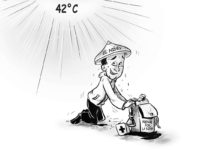[av_one_full first min_height=” vertical_alignment=” space=” custom_margin=” margin=’0px’ padding=’0px’ border=” border_color=” radius=’0px’ background_color=” src=” background_position=’top left’ background_repeat=’no-repeat’ animation=”]
[av_heading heading=’PEOPLE POWWOW ‘ tag=’h3′ style=’blockquote modern-quote’ size=” subheading_active=’subheading_below’ subheading_size=’15’ padding=’10’ color=” custom_font=”]
BY HERBERT VEGO
[/av_heading]
[av_textblock size=” font_color=” color=”]
Losing Dad to cigarettes
UNDER Executive Order 26, which President Rodrigo Duterte signed May 16 but announced only last Thursday, smoking is already prohibited in “enclosed” public places and public utility vehicles. Its intention is to minimize, if not curb, cigarette smoking.
I do not know how such EO would boost the existing law banning smoking in public places — Republic Act 9211 or Tobacco Regulation Act of 2003 — but this is not about that law. For whatever deterrent purposes it may serve cigarette addicts, I would rather dwell on how smoking snuffed life out of my father.
My Dad – Juan Vego – was a healthy man who ate vegetables daily as “antidote” to his smoking vice. When I was a grade-school boy, he would often ask either me or my brother Efren to buy two sticks of cigarettes for him. Whenever I asked why two sticks only, he would say it was his way of minimizing his daily consumption. By the end of the day, however, I would have gone to the sari-sari store seven to eight times. In other words, he smoked between 14 and 16 sticks a day.
Growing up, I thought it was normal for male adults to smoke. It made me happy seeing my father receive boxes of cigarettes from his friends during Christmas, since I would not have to run to buy him cigarettes for several days.
My mother Alicia, a non-smoker, would often advise us children not to follow the smoking habit of our father. To which he would add, “Follow what I say, not what I do. Smoking is bad for your health.”
Out of curiosity, however, once in high school and away from home, I would occasionally light a stick. It took days before I, too, began craving the puff.
Fortunately, I succeeded stopping before it could become an addiction. One of my techniques was to saturate my mind with books and magazine articles illustrating the mortal effects of cigarette smoking. I got scared.
I began telling Tatay about smoking-induced lung cancer that had killed people everywhere on earth. But he shrugged it off with a joke, “Not bad. That would launch my trip to heaven.”
In time, when I was already married and was a father of a son myself, I no longer feared that lung cancer would claim Dad. When he retired from his school work at age 65, he was still alive and literally kicking. He would boast of having a strong immune system even when a younger friend of his, also a smoker, had died of throat cancer.
Late in 1991, however, Dad went down with a bad cough. When ordinary medication could not stop it, we got him confined in a hospital. He got tethered to an oxygen tank and had to sleep in sitting position in order to breathe. By then, he had no choice but quit smoking.
His pulmonologist subjected him to laboratory tests, x-rays and CT scans, which all led to the finding that he had a thumb-size lung tumor, an indication of lung cancer.
Despite ebbing financial resources and the knowledge that his chance of recovery was “microscopic,” we agreed to have him operated on by a renowned surgeon. But we never revealed to him it was the big C consuming him. He lived for one more month until he succumbed to the disease in 1992 at age 72.
Unfortunately, there are still smokers who don’t learn from others’ experiences. They would rather learn from their own – alas, only when it’s too late. (hvego@gmail.com/PN)
[/av_textblock]
[/av_one_full]



